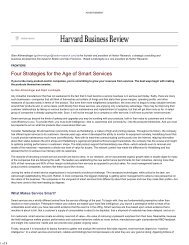Question and Questionnaire Design - Stanford University
Question and Questionnaire Design - Stanford University
Question and Questionnaire Design - Stanford University
Create successful ePaper yourself
Turn your PDF publications into a flip-book with our unique Google optimized e-Paper software.
296 Jon A. Krosnick <strong>and</strong> Stanley Pressertechnical terms, vague or imprecise predicate or relative terms, vague or imprecisenoun phrases, complex syntax, <strong>and</strong> working memory overload (Graesser, Cai,Louwerse, & Daniel, 2006). Users enter the item text <strong>and</strong> QUAID compares thewords to several databases <strong>and</strong> performs various calculations. For example, itidentifies a word as vague if its concreteness value in a psycholinguistics database isless than a threshold, <strong>and</strong> it diagnoses a question as involving complex syntax if thenumber of words before the main verb or main clause exceeds a threshold. Thethreshold levels were set to maximize the correlations with expert ratings for a smallset of items. 21A quite different computerized approach predicts an item’s measurement propertiesusing an equation developed from a meta-analysis of 87 multitrait, multimethodstudies of survey questions (Saris & Gallhofer, 2007). Users of the Survey QualityPredictor (SQP) assign each question a value for each of approximately 50 variablesranging from objective characteristics of the item, such as type of response options, tosubjective ones, such as the item’s social desirability. The program then outputscoefficients for each item’s reliability, validity, <strong>and</strong> method effect. In their study of 8income questions, van der Zouwen <strong>and</strong> Smit (2004) found no association betweenSQP scores <strong>and</strong> ratings from either experts or the QAS. But the very small number ofitems suggests caution in generalizing from these results. 229.10.2. Methods With Data CollectionMethods not involving data collection can only make predictions about whetheritems cause problems. By contrast, methods employing data collection can provideevidence of whether items, in fact, cause problems. The most common form of pretestdata collection — conventional pretesting — involves administering a questionnaireto a small sample of the relevant population under conditions close to, or identicalto, those of the main survey. Interviewers are informed of the pretest’s objectives, butrespondents are not. The data from conventional pretests consist partly of thedistribution of respondent answers to the questions, but mainly of the interviewers’assessments of how the questions worked, which are typically reported at a groupdebriefing discussion (though sometimes on a st<strong>and</strong>ardized form instead of, or inaddition to, the group discussion).Conventional pretest interviews may be used as the foundation for several othertesting methods. Behavior Coding, Response Latency, Vignettes, <strong>and</strong> RespondentDebriefings may all be grafted on to conventional pretest interviews.Behavior coding measures departures from the prototypical sequence in which theinterviewer asks the question exactly as it appears in the questionnaire <strong>and</strong> then therespondent provides an answer that meets the question’s aim. Coding may be carried21. QUAID may be accessed at http://mnemosyne.csl.psyc.memphis.edu/QUAID/quaidindex.html.22. SQP may be accessed at http://www.sqp.nl.
















